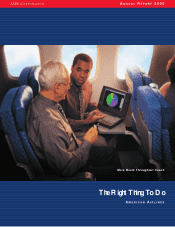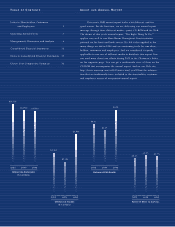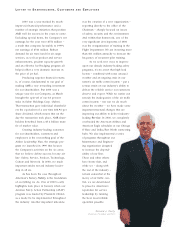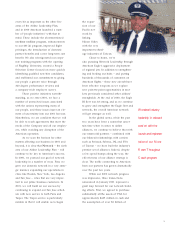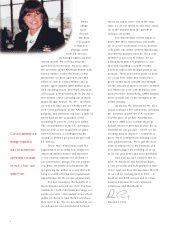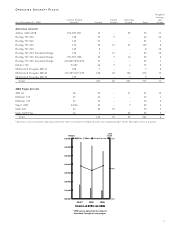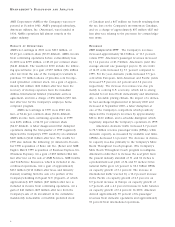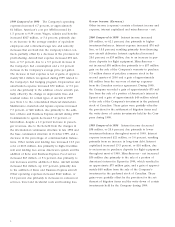American Airlines 2000 Annual Report Download - page 11
Download and view the complete annual report
Please find page 11 of the 2000 American Airlines annual report below. You can navigate through the pages in the report by either clicking on the pages listed below, or by using the keyword search tool below to find specific information within the annual report.
9
OPERATI NG ST AT I ST ICS
The following table provides statistical information for
American and AMR Eagle for the years ended Decem-
ber 31, 2000, 1999 and 1998.
Year Ended December 31,
200 0 1999 1998
American Airlines
Revenue passenger miles (millions) 1 1 6,594 112,067 108,955
Available seat miles (millions) 1 61 ,030 161,211 155,297
Cargo ton miles (millions) 2,280 2,068 1,974
Passenger load factor 72.4% 69.5% 70.2%
Breakeven load factor 65.9% 63.8% 59.9%
Passenger revenue yield
per passenger mile (cents) 1 4.05 13.12 13.49
Passenger revenue
per available seat mile (cents) 1 0.1 7 9.12 9.46
Cargo revenue yield
per ton mile (cents) 31 .31 30.70 32.85
Operating expenses
per available seat mile (cents) 1 0.38 9.39 9.25
Operating aircraft at year-end 71 7 697 648
AMR Eagle
Revenue passenger miles (millions) 3,731 3,371 2,788
Available seat miles (millions) 6,256 5,640 4,471
Passenger load factor 59.6% 59.8% 62.4%
Operating aircraft at year-end 261 268 209
LIQU IDITY AN D CAPITAL RESOURCES
Operating activities provided net cash of $3.1 billion in
2000, $2.3 billion in 1999 and $2.8 billion in 1998. The
$878 million increase from 1999 to 2000 resulted prima-
rily from a decrease in working capital.
Capital expenditures in 2000 totaled $3.7 billion,
compared to $3.5 billion in 1999 and $2.3 billion in
1998, and included aircraft acquisitions of approxi-
mately $3.1 billion. In 2000, American took delivery
of 27 Boeing 737-800s and 16 Boeing 777-200ERs.
AMR Eagle took delivery of 24 Embraer 135 aircraft
and five Embraer 145 aircraft. These expenditures, as
well as the expansion of certain airport facilities, were
funded primarily with internally generated cash and
the $559 million cash dividend from Sabre Holdings
Corporation, except for (i) 11 Boeing aircraft which
were financed through secured mortgage agreements,
and (ii) the Embraer aircraft acquisitions which were
funded through secured debt agreements.
At December 31, 2000, the Company had com-
mitments to acquire the following aircraft: 66 Boeing
737-800s, 23 Boeing 757-200s, 20 Boeing 777-200ERs,
146 Embraer regional jets and 25 Bombardier CRJ-700s.
Deliveries of all aircraft extend through 2006. Future
payments for all aircraft, including the estimated
amounts for price escalation, will approximate $2.7 bil-
lion in 2001, $1.6 billion in 2002, $900 million in 2003
and an aggregate of approximately $1.3 billion in 2004
through 2006. In addition to these commitments for
aircraft, the Company expects to spend approximately
$1.0 billion in 2001 for modifications to aircraft, ren-
ovations of – and additions to – airport and off-airport
facilities, and the acquisition of various other equipment
and assets, of which approximately $855 million has
been authorized by the Company’s Board of Directors.
The Company expects to fund its 2001 capital expendi-
tures from the Company’s existing cash and short-term
investments, internally generated cash or new financing
depending upon market conditions and the Company’s
evolving view of its long-term needs.
On January 10, 2001, the Company announced
three transactions that are expected to substantially
increase the scope of its existing network. First, the
Company announced that it had agreed to purchase
substantially all of the assets of Trans World Airlines,
Inc. (TWA) for approximately $500 million in cash and
to assume approximately $3.5 billion of TWA’s obliga-
tions. The Company’s agreement with TWA contem-
plated that TWA would file for bankruptcy protection
under Chapter 11 of the U.S. Bankruptcy Code and
conduct an auction of its assets under the auspices of
the Bankruptcy Court. During the auction, other credi-
ble offers would compete with the Company’s offer.
TWA filed for bankruptcy protection on January 10,
2001. In conjuction therewith, the Company also agreed
to provide TWA with up to $200 million in debtor-in-
possession financing to facilitate TWA’s ability to main-
tain its operations until the completion of this transac-
tion. The amount available under this facility was later
increased to $330 million. As of March 19, 2001,
approximately $289 million had been provided via the
debtor-in-possession financing.

